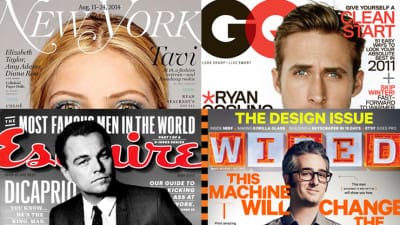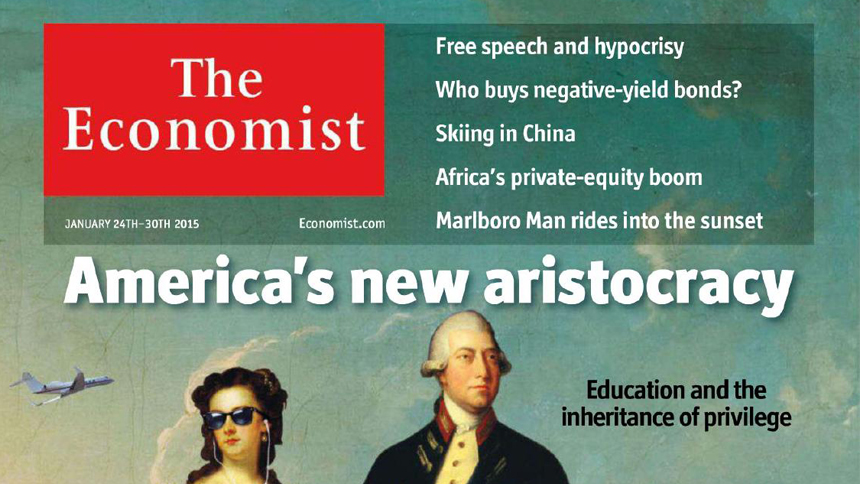Glamorous celebrity profiles and hard-hitting investigative reports may be the domain of the feature well. But when it comes to shaping a magazine’s identity, expressing its voice, and keeping readers engaged issue after issue, back- and front-of-book departments are editorial’s workhorse. “They’re fundamental to the success of a magazine,” says GQ deputy editor Michael Hainey, “If your sections aren’t good, your magazine won’t be either.”
The 2010 American Society of Magazine Editors’ National Magazine Awards will honor some of the year’s best magazine sections, ones that exemplified stellar service writing while innovating dynamic new ways to present information and entertain audiences. Those that made the cut: Esquire‘s unfailingly clever Man at His Best guide to pop culture, fashion, drinks and lifestyle; GQ‘s impeccably stylish Manual section on grooming and fashion, and its recently inaugurated, entertainment-focused GQ Intelligence department; New York‘s back-of-book Strategist, the all-knowing resource for food, real estate and shopping; and Wired‘s Start, the front-of-book repository for all things innovative.
Also on Mediabistro


“When you look at these four magazines, they all have a very firm idea of what their readers are most interested in and a very firm grip on a stylish kind of service journalism,” says Sid Holt, chief executive of ASME, which awards the Ellies. “Many of these finalists combine that with an intelligence, cleverness… and a last thing — a sort of X-factor — some spark or element of the unexpected that makes the section especially captivating for readers.”
Editors from all four nominated magazines try to put their fingers on just what elevates a magazine section to greatness. Here’s their advice.
1. Shun the Obvious
The X-factor Holt mentioned is the starting point for planning the front of the book, says Ross McCammon, articles editor at Esquire and top editor on Man at His Best. “My first note that I ever got from my boss [on a proposed article] was, ‘This seems like something a magazine would do,'” McCammon says.
“That, first of all, was the most confusing note I ever received, until I understood what he was talking about.” The message, of course, was that front-of-book articles needed to reach beyond the conventional, “either stylistically with the writing, with the format or with the opinion itself,” he says. “There needs to be something surprising about it.”
So, in a recent issue, instead of reviewing Ben Stiller’s new movie, Greenberg, in their March issue, Esquire ran an ode to the actor’s touchingly awkward sex scenes. And rather than print an essay about HBO’s show Treme, they ran a quiz for readers to determine whether they should bother watching it.
“A lot of people are going to be covering that particular show,” McCammon says. So Esquire decided on a quiz to both inform viewers about the show and offer a commentary on the time commitment such a series requires. “And frankly,” he adds, “I think the format is good for jokes. The cool thing about a quiz is that it’s sort of absurdist and useful at the same time, and to me that’s a beautiful thing.”
2. Put Relevance First
At New York, editors keep the Strategist section relevant by synthesizing current events and service journalism into articles that are both useful and timely, says deputy editor Jon Gluck. “We try to look for things that are news-driven and that help solve New Yorkers’ problems in a way that’s ambitious, imaginative and super useful to them,” he says.
“Whenever an urban living problem comes up, we try to jump on it.” So, for example, when Mayor Michael Bloomberg began his war against salt, Strategist put together an extensive salt feature, analyzing the sodium content in favorite New York dishes, surveying gourmet salts and offering a Morgan Spurlock-like diary of a nine-day salt binge.
Gluck says that, as a weekly section, Strategist needs to be on the cutting edge of its beats — food, real estate and fashion — to deliver that relevant news. “The quality of the section depends on how authoritative and useful the information is, and that depends on the people we’ve got covering these worlds,” he says. The writers all have “an almost obsessive interest in their beats. … That depth of knowledge is what we’re for.”
3. Do What Magazines Do Best
Providing useful, well-written and skillfully reported information is important, but it’s not enough anymore, says Wired senior editor Robert Capps. After all, readers buy a magazine like Wired because it offers a unique voice and because the physical experience of reading the magazine in print is something that can’t be had elsewhere.
So, Capps, who oversees Wired‘s Start section, looks for stories that “convey the Wired sensibility: enthusiasm about technology, a DIY attitude and a certain level of smarts.” After that, he says, it’s about presentation. “The really cool thing about the front of the book is that it’s so collaborative. It really takes advantage of the magazine format. The best front-of-book sections have really dynamic interactions between editorial and art departments to come up with lively takes on information.”
Covering business, technology, science and “general geekery,” Start includes anything from a flow chart offering advice on whether to “Delete that Tweet” to a chemical analysis of Scope to the long-running “Dangerous Object of the Month,” (recently, Pure Cap Hot Sauce).
Combining novel articles with bold presentations and a mix of reliable “furniture” pieces that readers turn to each month is essential, he says. “The Internet is so voracious at telling people that stuff exists, so you need to have an attitude and to take advantage of the specific medium,” Capps says. “The best sections really leverage all of that to their advantage.”
4. Assume the Role of Curator
The transformation and fragmentation of the media market, and the impact of the 24-hour online news cycle, have been very much on the minds of editors at GQ, Hainey says. In fact, the magazine launched GQ Intelligence, one of its two nominated sections, just last year, as an effort to re-imagine arts and entertainment coverage in the Internet age. “We launched that section with the intent to answer that single question, which is, ‘What really matters in the pop culture universe?'” he says.
“There are a dizzying number of entertainment options that come through the filter,” he says. “So that role of the cultural filter is for a magazine even more important.” At Intelligence and GQ‘s other nominated section, Manual, the idea of distilling content into what’s most interesting and essential drives coverage of everything from fashion and grooming to politics and sports.
Hainey points out that GQ‘s considers that sense of authority equally essential to covering the season’s must-have cotton suits, artisanal butchers or the political implications of The Clinton Tapes. Across the board, he says, “There’s a great sense of responsibility those editors carry in filtering content and putting that imprimatur on the material.”
5. Prepare to Go Digital
Internet adoption has already propelled the magazine industry to a pivotal moment, and now, magazine publishers are betting on the transformational impact of the Apple iPad and other tablets coming onto the market this year.
“Mr. Magazine” Samir Husni, professor at University of Mississippi, says the industry can’t afford to ignore its digital future — and format-forward front-of-book sections are poised to lead that charge. Wired, for one, has already been attracting buzz for its tablet edition, which premieres alongside the June issue.
Capps says editors are working with developers to offer videos, animations and other online extras, “so when you look at the iPad you’ll get that extended dance remix,” of what’s in the print edition. He says that, while the print edition will retain primacy, “I can imagine that a great tablet feature will help elevate something to make it into the section.”
Husni says that creating an experience, engaging and activating readers, has always been key to producing a successful magazine. Now, he says, that experience needs to translate across multiple media. “The more service and the more interactivity [magazines] create, whether using new technologies like augmented reality or text messages, and the more we can make our print editions interactive, the better those sections will be. That’s what our audiences are looking for,” Husni says. “That’s the only way we can ensure a future for print in a digital age.”



.png)





